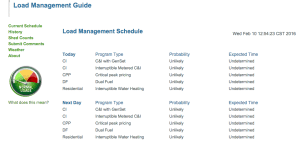Electric Co-ops Launch “Community Storage” Initiative
Electric cooperatives are poised to increase their use of electric water heaters as a demand response (DR) and energy storage tool in their service territories.
The 50 million residential electric water heaters in the U.S. collectively represent a significant—and vastly underutilized—energy storage resource capable of leveraging substantial environmental and cost benefits, according to new research by The Brattle Group that was commissioned by the National Rural Electric Cooperative Association (NRECA), the environmental organization Natural Resources Defense Council (NRDC), the Peak Load Management Alliance (PLMA), and Great River Energy (GRE).
The Brattle Group announced findings from “The Hidden Battery: Opportunities in Electric Water Heating” today at the launch of an initiative—The National Community Storage Initiative—designed to promote growth in a novel, community-based approach to energy storage dubbed “community storage.”
Although this initiative may sound like a variation on an approach to solar power generation known as “community solar,” it is different in two major ways: The storage is thermal only (and can’t feed electrons back to the grid), and in contrast with community solar, where multiple customers buy in to a solar project at a single site, with community storage, the storage devices are distributed throughout the service territory.
The groups sponsoring the Brattle study said that by aggregating distributed energy technologies and home appliances, electric cooperatives are developing community storage to increase energy efficiency, better integrate renewable energy resources onto the grid, and reduce customers’ monthly electric bill.
Smart Grid Application
One such community storage program managed by Minnesota-based generation and transmission cooperative Great River Energy has been able to store a gigawatt-hour of thermal energy each night by charging the electric resistance water heaters of 65,000 end-use members.
GRE provides wholesale electric service to 28 Minnesota distribution cooperatives. Those member cooperatives distribute electricity to approximately 655,000 member-consumers. GRE spokesperson Therese LaCanne told POWER that the portfolio of DR programs offered by GRE and its members are able to control up to 350 MW of load, which includes not only water heaters but also air conditioners, heating systems, and irrigation systems.
In a conversation with POWER, Gary Connett, director, member services and demand-side management for GRE, confirmed that a bill that passed Congress in 2015, the Energy Efficiency Improvement Act of 2015, helped enable roll-out of the new initiative announced today.
GRE’s DR program works with water heaters from three specific manufacturers that offer high efficiency. Under the current program, they are grid-connected from 11 p.m. to 7 a.m., Connett said, and then when the DR program is in effect, they are disconnected until the next charging period.
“At Great River Energy, we believe there’s a battery hidden in basements all across our service territory,” Connett was quoted as saying in today’s release. “When the wind is blowing or the sun is shining, large capacity water heaters can be enabled to make immediate use of that energy to heat water to high temperatures. The water heaters can be shut down when renewables are scarce and wholesale costs are high.”
The screenshot below shows the co-op’s online display of various load management elements and the likelihood of each option being used.

Even in regions heavily reliant on coal and natural gas to generate electricity, the Brattle research shows that consumers have options for saving money on their electric bills and reducing carbon dioxide emissions associated with their water heating. The emission reductions of community storage will compound as more consumers participate and the electricity sector transitions to cleaner fuels and generation technologies, the report predicts.
Lower Costs for Consumers
“Co-ops have been controlling large water heaters for decades in order to reduce demand at peak times, which also reduces members’ electric bills. A community storage program using advanced water heaters allows us to do even more: we can store energy, we can optimize the power grid by shaping demand and we can integrate more renewable resources,” said Keith Dennis, NRECA’s senior principal for end-use solutions and standards.
“Smart, grid-connected electric water heaters represent a promising possibility for a more efficient, more economic, and ultimately lower-emissions electricity system,” said Robin Roy, director of building energy efficiency and clean energy strategy at the NRDC. “Given that water heating represents more than 15 percent of household energy use, this is a great opportunity to cut energy waste and also the emissions from electricity generation.”
“The National Community Storage Initiative will focus attention on the immediate opportunity for national, regional and local market development efforts to demonstrate the potential of ‘behind-the-meter’ electric storage technologies,” said Rich Philip, manager of products and services at Duke Energy, and PLMA chairman.
About The Brattle Group’s Study
The research examines the economic and grid benefits of controlling three different types of water heaters (80-gallon electric resistance, 50-gallon electric resistance, and heat pump water heaters) for peak shaving, thermal storage, and real-time fast response to supply fluctuations. Researchers modeled these program designs using 2014 data from the PJM and MISO markets.
The Brattle researchers also modeled these programs using projected prices and energy resources in MISO in 2028 to determine the economic and environmental potential of electric water heaters to provide energy services to the grid in the future.
—Gail Reitenbach, PhD, editor (@GailReit, @POWERmagazine)